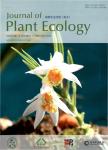Projecting the distribution and abundance of Mediterranean tree species under climate change:a demographic approach
作者机构:CREAFUniversitat Autònoma de Barcelona(Edifici C)Cerdanyola del Vallès 08193Spain Departament de Biologia Animalde Biologia Vegetal i d'EcologiaUniversitat Autònoma de Barcelona(Edifici C)Cerdanyola del Vallès 08193Spain
出 版 物:《Journal of Plant Ecology》 (植物生态学报(英文版))
年 卷 期:2017年第10卷第5期
页 面:731-743页
核心收录:
学科分类:0710[理学-生物学] 0907[农学-林学] 07[理学] 0701[理学-数学] 0713[理学-生态学]
基 金:MSc grant from‘Obra Social La Caixa’to D.G.C.and the CARBOSTOCK project(MICINN 18533)to D.G.C.
主 题:climate change demographic model Pinus halepensis Mediterranean population dynamics
摘 要:Distribution and abundance patterns of species arise from the spatiotemporal dynamics of demographic processes.Population rates of birth,death,growth and patterns of dispersal are,in turn,influenced by environmental conditions and biotic interactions.However,current approaches for modelling large-scale geographical patterns often bypass these simple premises.centred in the mainland territory of Spain and using Pinus halepensis as a case study,our goal was to gain insight into the main driv-ers affecting local demographic processes,and how large-scale distribution and abundance patterns are shaped by these local variations in vital rates.Methods We applied the integral projection methodology to develop a spa-tially explicit demographic model of tree species in mainland Spain,using individual-level data from a national forest inventory.In our integral projection model,environmental conditions and competi-tive interactions influence the survival,growth and reproduction of trees,and we model explicitly the dynamic colonization of new patches.With this framework,the projected distribution and abun-dance patterns of P.halepensis up to 2090 were evaluated under two different climate scenarios.Important Findings When environmental conditions were kept constant,popula-tions tended to decrease in net number of adults and to increase in net basal area,thus consisting in fewer and bigger individuals.Accounting for climate change in our simulations exacerbated the trend in mortality,causing widespread losses in number of trees,and few locations maintained populations of100 adult individu-als per hectare.the expected increase in mortality under climate change,on the other hand,prompted a higher degree of regeneration via the release of niche space,although not enough to maintain current abundance levels.colonization spatial patterns did not vary significantly with climatic conditions,but the species was able to increase its distribution under climate change more than in a constant climate scenario.Our approach yields relevant information at different spatial scales,from plot-level processes to large-scale abundance patterns.With it,we clearly indicate the strong role that climate change could have in shaping future forest communities through its differential influence on demographic processes.



